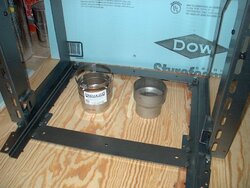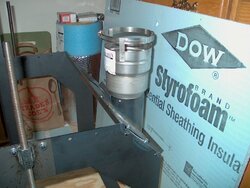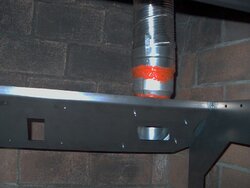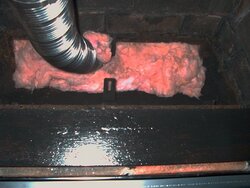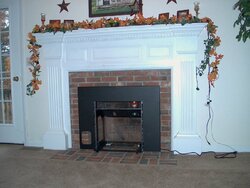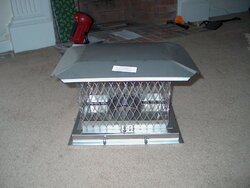Hi,
Wow, I read your post and it was like deja vu of all my questions as I just purchased and installed my own P35i insert. I bought the stove in the last week of September, ordered my own chimney liner system and installed the whole thing myself with a friend to help me run the liner down the chimney. I just fired it up today 11/6/10 for the first time.
Here's what I did... I ordered a stainless steel chimney liner kit from Woodland Direct (
http://www.woodlanddirect.com ) I got the 316Ti 4" liner with the deluxe terracotta flue cap and the appliance connector (which was 4" to 4" not really what I needed). What I soon realized was that the flue stub on the P35i inserts mounting frame is an odd size. What I also soon realized is that there are no standards in the fireplace industry. Soooo... the appliance connector I got with the chimney liner kit was too big to fit inside the flue stub. What I did next was throw the mounting frame into my car and bring it around to a few different stove shops and ask them how I could adapt the flue stub on the cage to my 4" flex liner. We tried several adaptors like a 4" to 3" but that was too small. Finally what I ended up doing was calling back my salesman at Woodland Direct, sending him a digital photo of the mounting frame flue stub with the inside dimension which on mine measures 3-5/16". They then made me a custom adaptor that went from the 3-5/16" flue stub to then fit the end of the original appliance connector they sent me.
So then I had the following: 4" flex pipe to 4" O.D. to 4" I.D. appliance connector to 4" appliance connector to 3-5/16" flue stub. One more connection than I would have liked, but it's pretty clean just the same. Then I had a friend drop a tape measure down the chimney with the mounting frame in place and the custom adaptor inserted in the flue stub and I measured from the top of the terracotta liner to the custom adaptor. We added a few inches to be sure, then cut the liner to length with a hack saw. Next, I siliconed the appliance connector to the chimney liner with Red High Temp 600 degree F silicone, and used the band clamp to secure the connector to the liner.
In Massachusetts we are required to run the liner the full length of the chimney. I had to remove my damper plate to get the 4" flex liner through the damper opening. I just pulled the cotter pin from the damper handle and removed the handle. Then I just lifted the damper plate out of the opening. I tied one end of a rope to the damper handle that I removed, and secured the other end of the rope to the appliance connector that I had previously siliconed to the flex liner. I then had my friend lower the rope from the top of the chimney and I grabbed it from inside. As he fed the liner down the chimney I kept some tension on the rope to help the liner down the chimney.
I then siliconed the custom adaptor to the flue stub on the mounting frame and secured it with two stainless steel screws through the holes in the flue stub. Next I attached the surround panels to the mounting frame and set the mounting frame in the fireplace opening and leveled it side to side and front to back with the leveling bolts, making sure none of the weight was resting on the surround panels. Once in place I secured the frame into the fireplace opening by tightening the threaded rods up onto the lintel bar in the top of the fireplace opening. Then I smeared the outside of the appliance connector with high temp silicone and slipped it into the custom adaptor on the mounting frame. Finally I stuffed R19 pink fiberglass into the damper opening around the liner to seal off the bottom of the chimney. At this point I left the bottom connection alone and waited for the silicone to dry on the joints.
Now I went and worked on finishing the connection at the top of the chimney. First I centered the liner in the terra cotta liner as best I could and then stuffed pink fiberglass around it about 1 foot down inside the terra cotta liner. Then I slipped the liner through the opening in the chimney cap and then set the chimeny cap down on the terra cotta and secured it with the screws. Finally I tightened the band clamp screw to secure the liner to the cap. When the silicone had dried the next day, I ran another heavy bead around the outside of the three seams on the pipe at the connections near the flue stub. I then gave that a few days to dry.
I asked my dealer about the outside air kit and they assured me that it was not necessary. I guess that if your house isn't super tight, or super small, drawing combustion air from the room is acceptable. I have mixed feelings about this and plan to do some more investigating on the subject, as I can always add it later. I had my building inspector come up at this point before I slide the stove into the mounting frame and connected the electronics and fired it up. He passed it without requiring the outside air kit as well.
The idea of using the fiberglass insulation at the top and bottom of the chimney helps to keep the warm air in the chimney around the stainless steel liner to help with the draft and prevent condensation. Probably not the best setup if you are going to try the outside air kit with the flex tube 1/2 way up the chimney. You would also want to use a chimney cap with slotted holes in the side to allow air to be drawn in.
I had questions about the steel plate they recommend to use to seal the damper plate opening off, but then after reading it several times, I believe that is only necessary if you are not going to run the liner to the top of the chimney like I did. If you are only going to run the liner a short distance into the first terra cotta liner as you mentioned, then the steel plate is required.
I have some great pictures I took of the flue stub custom adaptor and how I connected the liner and installed the frame into the fireplace opening if you'd like to see them. I will post them tomorrow if your interested. Hope that helps... Go slow, and take your time, and you'll figure it out.


